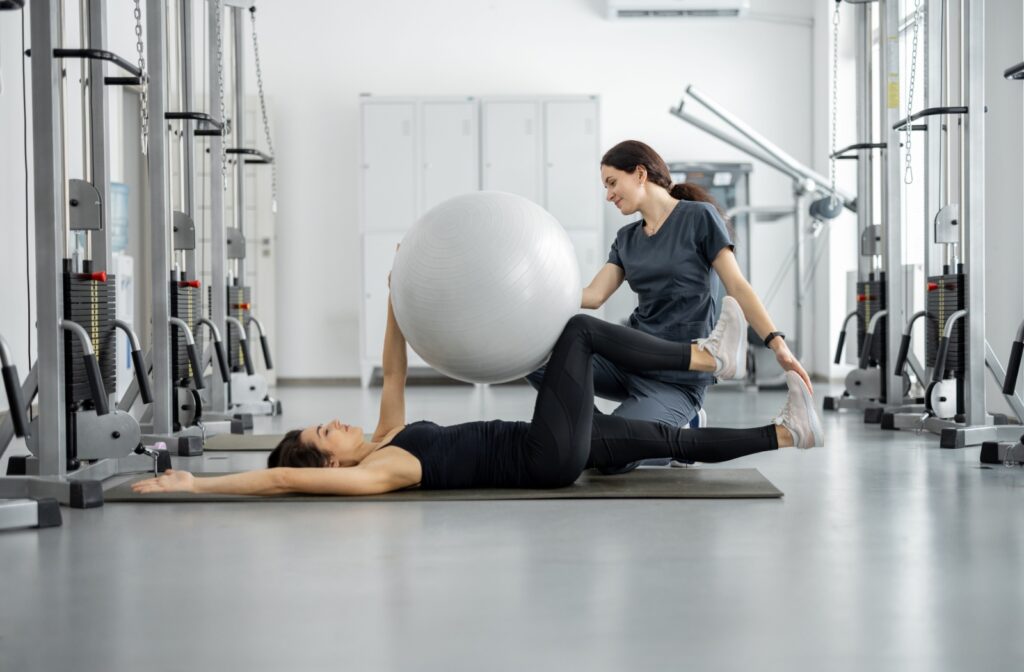It’s easy to chalk up lingering aches during your favourite activities to getting older or overdoing it at the gym. However, these aches and pains might be telling you something important about your body’s needs. Ignoring these signs often leads to injury and time away from the activities that you love while you’re forced to recover.
While physiotherapy can help you get back on your feet, you don’t have to wait until you’re injured to act. Prehabilitation is a proactive approach to physical therapy, focusing on preventing injuries and enhancing performance, often before surgery or other medical treatments.
The Differences Between Rehab & Prehab
Traditional physiotherapy rehabilitation is all about getting active people back on track. It’s a journey to restore physical function and performance after an injury. This can involve targeted exercises, stretches, and manual therapies, including soft tissue work, joint glides, and deep tendon friction techniques. The aim is to safely and effectively bring athletes back to their pre-injury activity levels.
The benefits of rehabilitation include:
- Restoring function: Rehabilitation enables patients to regain physical abilities and resume daily activities with greater ease and confidence.
- Faster recovery: A structured rehab plan promotes faster and more effective healing, minimizing downtime.
- Reducing future injuries: By focusing on strength building and flexibility, rehabilitation helps reduce the risk of re-injury.
Strengthening weak muscles is key to keeping your body working smoothly. Think of your body as a chain—movement in one part affects the whole. If one part is weak, it can cause imbalances and stress elsewhere, leading to injury. But it’s often not enough to see a weak link and try to strengthen it; we need to understand why that link is weak.
A knee injury could be caused by a weak ankle or hip putting stress on your other joints. By only treating the symptom, we may be missing the cause. PREhab is about taking the long view, not only just in terms of time, but also by seeing your body as a single well-tuned machine.
Prehabilitation, or “prehab,” flips the traditional rehabilitation model on its head. Instead of addressing injuries after they occur, prehab takes a preventive stance. This approach is about strengthening and preparing the body to avoid injuries altogether, and it’s particularly useful before surgeries or intensive physical activities, such as intense training for sport or upcoming competition.
How Prehab Differs from Rehab
While both prehab and rehab are essential, they serve different purposes:
- Rehabilitation focuses on recovery after an injury. It uses targeted exercises to help you return to pre-injury function.
- Prehabilitation emphasizes prevention through education. By engaging in specific exercises and routines, you can significantly reduce the risk of injuries and improve overall performance.
Both approaches complement each other, working together to promote comprehensive recovery and injury prevention.
Benefits of Prehabilitation
Prehabilitation’s benefits are comparable to those of rehab, including:
- Reduced risk of injury: Prehab can help fortify your body against potential injuries. By building strength and mobility, you lower your chances of sustaining injuries during activities.
- Improved recovery: If you’re getting ready for a sports event or preparing for surgery, prehab equips your body to handle the physical stress better. This can lead to a smoother recovery process.
- Enhanced performance: Because prehab is about getting your body ready to be active, it can translate to improved speed, agility, and strength, enhancing your overall performance.
While the benefits are similar to those of normal rehab, prehab has at least 1 huge benefit over rehab: you can prevent the injury in the first place. The human body has an incredible ability to heal itself, but recovery can still be long and difficult. Not only that, the psychological effects of injury can linger long after skin and bone have mended. Even common neuromusculoskeletal issues can burden our healthcare system, so taking care of yourself can also be a way to care for your community.
Prehab can mean less time tending to injuries and more time enjoying your life!

Who Can Benefit from Prehabilitation?
Prehabilitation isn’t just for athletes. Weekend warriors, part-time marathon runners, and health enthusiasts of all stripes can greatly benefit from this proactive approach.
Plus, it’s a legitimate part of surgical care, taking some of the postoperative recovery and moving it into preoperative prep. We tend to think of physiotherapy as being for orthopedic surgeries like knee/hip replacements, back surgery, rotator cuff repairs, and more. However, cardiac, oncology, and even neurology surgeries can benefit by preparing the body and mind for the stresses involved. This means less time spent recovering and more time enjoying the changes these surgeries offer.
Prehabilitation Techniques
You can start “prehabing” your injuries today by incorporating some of these approaches into your daily routine:
- Strength training is key: Consistently engage in exercises aimed at building muscle strength and joint stability. Exercises such as squats, deadlifts, and push-ups that focus on various muscle groups can enhance overall physical resilience.
- Muscle activation: Warm up your muscles with specific activation exercises before engaging in physical activity. This prepares your muscles for the workout ahead, reducing the risk of strain or injury. You can think of it like “waking up” muscles that might need some extra encouragement to be active during bigger movements, such as squats.
- Mobility exercises: Incorporating movements that focus on increasing joint range of motion can aid in maintaining flexibility and functional movement patterns. Consider introducing exercises like leg swings or torso twists into your routine.
- Stretching: Regular stretching routines help maintain elasticity in muscle fibres and promote circulation. Make sure to include both static and dynamic stretching routines to complement your strength and mobility work.
- Mental preparation: Prepare yourself mentally for physical activity through techniques such as visualization, meditation, and controlled breathing exercises. Mental readiness can enhance focus and performance, thereby contributing to injury prevention.
Unlock Your Potential with Prehabilitation
Prehabilitation is a powerful tool that empowers you to take control of your physical well-being. It’s an investment in a future of active and pain-free living. At Recovery Lab, our expert team is here to educate you on what you should incorporate into your daily routine to manage your aches and pains while still working toward your unique goals.
Book an appointment with us today and discover the benefits of prehabilitation for yourself. Remember, preparation is key to success—and failing to prepare is preparing to fail.
Let’s work together to help you stay at your best!



